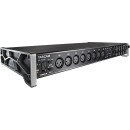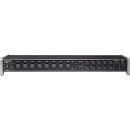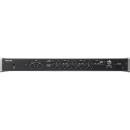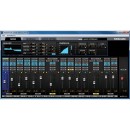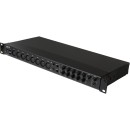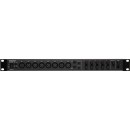TASCAM US-16x08 USB Audio/MIDI Interface Review
- 16-input, 8-output USB audio interface
- 8 Ultra-HDDA microphone preamps with 56dB of gain
- 2 instrument-level inputs
- 8 balanced line inputs
- Up to 24-bit/96kHz resolution
- MIDI input/output
- Zero-latency monitoring
- Integrated DSP mixer with 4-band EQ and compression
- Rugged metal chassis
- Compatible with Windows and Mac OS
In-Depth Specifications, Advantages, and Disadvantages
The TASCAM US-16x08 USB Audio/MIDI Interface is a versatile and robust solution for musicians, producers, and audio engineers seeking high-quality audio recording and playback capabilities. Featuring 16 microphone and line inputs along with 8 balanced line outputs, this interface provides ample connectivity for multi-microphone setups, instruments, and other audio sources. Each input includes a high-quality Ultra-HDDA mic preamp, ensuring clean and transparent sound capture with minimal noise.
Designed with ease of use in mind, the US-16x08 comes equipped with a user-friendly control panel and dedicated software for both Mac and Windows, facilitating seamless integration with your preferred Digital Audio Workstation (DAW). Additionally, it offers MIDI input and output ports for connecting external MIDI devices, making it an all-in-one solution for comprehensive music production.
The build quality of the TASCAM US-16x08 is solid and reliable, featuring a rugged metal chassis that can withstand the rigors of both studio and live environments. With its intuitive interface, extensive connectivity options, and superior audio performance, the TASCAM US-16x08 is an excellent choice for anyone looking to elevate their audio production capabilities.
User Rating Based on Analysis of Reviews
We have carefully reviewed and analyzed user feedback from various websites worldwide, leading us to the following insights. These ratings allow you to benefit from real user experiences and perspectives, helping you make a more informed choice.
Purchase Value
75% of users felt that the TASCAM US-16x08 offers great value for money. They appreciated the wide range of inputs and outputs, and the overall functionality that competes with more expensive models. Many users mentioned that the interface met or exceeded their expectations, especially for home studio use. The price point was considered reasonable, given the features and quality of sound it provided.
25% of users were dissatisfied with the purchase value, expressing that the interface was not as cost-effective as anticipated. Some users noted that for a similar price, other products offered more reliable software and support. There were complaints about hidden costs, such as needing additional accessories to fully utilize the device’s capabilities.
Quality of Materials
80% of users praised the TASCAM US-16x08 for its sturdy build quality. They highlighted the solid metal chassis that could withstand frequent use, making it suitable for both studio and live settings. The knobs and connectors were described as robust, giving users confidence in the product's durability over time.
20% of users were dissatisfied with the materials, citing issues with the plastic components that felt cheap compared to the rest of the unit. Some users experienced problems with the durability of the knobs and switches, which they felt could wear out with regular usage. A few also mentioned that the unit did not feel as premium as they expected.
Sound Quality
85% of users were highly satisfied with the sound quality of the TASCAM US-16x08. They reported clear, crisp audio with minimal noise, and appreciated the preamps which provided clean gain. The audio interface was praised for its ability to handle a wide dynamic range and maintain fidelity across different recording settings.
15% of users were not satisfied with the sound quality, pointing out issues such as occasional hissing or buzzing noises. Some users felt that the preamps did not provide enough gain for quieter microphones, and there were complaints about the sound quality deteriorating at higher input levels.
Ease of Use
70% of users found the TASCAM US-16x08 easy to use, attributing this to its straightforward interface and intuitive controls. The device was generally considered user-friendly, with clear labeling on inputs and outputs, making it accessible for beginners and professionals alike.
30% of users found the product challenging to use, citing difficulties with the initial setup and software installation. Some users struggled with configuring the interface with their digital audio workstations (DAWs), and there were reports of the documentation lacking clarity, which complicated the learning curve.
Driver Stability
65% of users were satisfied with the driver stability, noting that once installed, the drivers were reliable and provided stable performance. They appreciated the updates that addressed previous bugs and improved compatibility with various operating systems.
35% of users expressed dissatisfaction with driver stability, encountering frequent disconnects or compatibility issues with certain operating systems. Some users reported crashes during recording sessions, which disrupted their workflow, and felt that the driver's performance was inconsistent.
Connectivity Options
90% of users were satisfied with the connectivity options offered by the TASCAM US-16x08. They appreciated the ample number of inputs and outputs, which allowed them to connect multiple instruments and external devices simultaneously. Users found the interface versatile for various recording setups.
10% of users were dissatisfied with the connectivity options, mentioning that while the number of ports was adequate, the placement of some connections was inconvenient. A few users also noted compatibility issues with certain peripheral devices.
Portability
60% of users were satisfied with the portability of the TASCAM US-16x08, noting that despite its size, it was relatively easy to transport. The robust build quality added to their confidence in taking the interface on the road.
40% of users were dissatisfied with the portability, primarily due to its larger size and weight compared to other interfaces. Some users found it cumbersome to carry, particularly when traveling frequently, and felt it was not as travel-friendly as they had hoped.
Customer Support
55% of users were satisfied with the customer support offered by TASCAM, finding the service team helpful in resolving technical issues and providing guidance during setup. They appreciated the quick response times and knowledgeable representatives.
45% of users were dissatisfied with customer support, citing long wait times and unhelpful responses. Some users felt that their issues were not adequately addressed and experienced delays in receiving necessary support, which frustrated them.
Software Compatibility
70% of users were satisfied with the software compatibility of the TASCAM US-16x08, noting that it worked well with major DAWs and operating systems. They found the setup process straightforward once compatible software was identified.
30% of users were dissatisfied with software compatibility, reporting issues with certain DAWs or operating systems that required additional configuration. Some users faced challenges in finding updated drivers or experienced bugs that hindered the interface's performance.
Latency
75% of users were satisfied with the low latency performance of the TASCAM US-16x08, praising its ability to provide real-time monitoring without noticeable delay. This was particularly appreciated during live recording and performances.
25% of users were dissatisfied with the latency, experiencing delays that affected their recording sessions. Some users noted that the latency worsened with higher track counts, and they felt the latency was not as low as advertised for high-performance needs.
Durability
85% of users praised the durability of the TASCAM US-16x08. They found the metal chassis and solid construction to be resilient against wear and tear, making it a reliable choice for both studio and live environments.
15% of users were dissatisfied with the durability, citing issues such as faulty connectors or components breaking after limited use. A few users reported that the unit did not withstand transportation well, leading to damage over time.
Input/Output Configuration
90% of users were satisfied with the input/output configuration of the TASCAM US-16x08, appreciating the flexibility it offered for various recording setups. The multiple inputs allowed for simultaneous recording of several instruments or microphones, which was a key advantage for many users.
10% of users expressed dissatisfaction with the input/output configuration, feeling that certain connections could have been better positioned for easier access. Some users also mentioned that they encountered limitations when integrating with specific gear setups.
Aesthetic Design
80% of users were satisfied with the aesthetic design of the TASCAM US-16x08, describing it as sleek and professional. The design was seen as both functional and visually appealing, fitting well into various studio setups.
20% of users were dissatisfied with the design, feeling that it was too bulky or lacked certain ergonomic features. Some users mentioned that the design did not match the aesthetic of their other equipment, which was a minor but noted concern.
Preamp Quality
85% of users were highly satisfied with the preamp quality of the TASCAM US-16x08. They appreciated the clean, noise-free gain that the preamps provided, which enhanced the overall sound quality in recordings.
15% of users were dissatisfied with the preamp quality, mentioning that they did not provide enough gain for certain dynamic microphones. Some users also experienced noise issues at higher gain settings, which impacted their recording quality.
Versatility
88% of users praised the versatility of the TASCAM US-16x08, noting its ability to adapt to a wide range of recording scenarios. The variety of inputs and outputs, coupled with its compatibility with different software, made it a versatile tool for both beginners and advanced users.
12% of users were dissatisfied with the versatility, feeling that while the interface offered many features, it could be overwhelming to set up and configure for specific tasks. A few users also noted limitations when trying to use it for more specialized recording needs.
Learning Curve
65% of users found the learning curve manageable, especially those with prior experience using audio interfaces. They mentioned that once familiar with the setup, the interface was straightforward to operate and integrate into their workflow.
35% of users found the learning curve steep, particularly for beginners without technical expertise. Some users struggled with understanding the functionality of various features and required additional support to fully utilize the interface's capabilities.
Power Supply
78% of users were satisfied with the power supply of the TASCAM US-16x08, appreciating its reliability and the device's ability to function consistently without power fluctuations. The external power supply was seen as a stable solution.
22% of users were dissatisfied with the power supply, expressing concerns about the bulkiness of the adapter and its susceptibility to damage. Some users preferred a more compact or integrated power solution and experienced issues when the power supply was not handled carefully.
Size
70% of users were satisfied with the size of the TASCAM US-16x08, finding it appropriate for their studio setups. They appreciated the compact nature relative to the number of features offered, which saved space without sacrificing functionality.
30% of users were dissatisfied with the size, feeling that the unit was too large for smaller workspaces or mobile setups. Some users found it difficult to fit the interface into their existing gear configurations without reorganization.
Installation Process
68% of users found the installation process straightforward, especially those with experience setting up audio interfaces. They mentioned that with the right drivers, the setup could be completed efficiently and without major issues.
32% of users found the installation process challenging, encountering problems with driver installation and compatibility. Some users had to seek additional support to resolve setup issues, which they felt complicated the initial experience with the product.
Hardware Integration
83% of users were satisfied with the hardware integration of the TASCAM US-16x08, noting that it worked seamlessly with their existing equipment. The interface's ports and connections were compatible with a wide range of audio gear, enhancing its functionality.
17% of users were dissatisfied with hardware integration, experiencing problems when connecting with certain devices or instruments. Some users noted that additional adapters or cables were necessary for optimal integration, which added to the setup complexity.
In this section, we will review the detailed specifications of the TASCAM US-16x08 USB Audio/MIDI Interface. We'll also discuss the advantages and disadvantages of this product to provide you with a comprehensive understanding of its performance and features.
Pros:
- Eight XLR microphone inputs with Ultra-HDDA mic preamps for high-quality audio capture.
- Eight TRS line inputs for versatile connectivity options.
- MIDI input and output for integrating MIDI devices.
- Direct monitoring with a dedicated control software for zero-latency tracking.
- Durable build quality with a metal chassis for road-readiness.
- Compatible with both Windows and Mac operating systems.
- Supports up to 96kHz/24-bit audio resolution for professional-grade recordings.
Cons:
- Lacks onboard DSP effects for real-time processing.
- No ADAT or SPDIF expansion options, limiting future scalability.
- Some users report driver stability issues on certain systems.
- Relatively large and heavy, which may be less convenient for portable setups.
- No separate headphone volume control, which can be limiting for monitoring.
General
| Channels of I/O | 16 Input / 8 Output |
|---|---|
| Built-In DSP | Yes |
| Maximum Sampling Rate | 96 kHz / 24-Bit |
| Number of Microphone Inputs | 8 Preamps |
| Built-In Microphone | |
| Input Level Adjustment | 10x Knob |
| Expansion Slots |
The TASCAM US-16x08 USB Audio/MIDI Interface boasts impressive specifications that cater to a range of audio production needs. Show More
The feature labeled Channels of I/O indicates the number of input and output channels available on the device. With 16 inputs and 8 outputs, this interface allows for extensive connectivity, making it suitable for recording multiple instruments or vocals simultaneously while providing sufficient output options for monitoring or routing audio.
Next, the Built-In DSP signifies the presence of Digital Signal Processing capabilities within the interface. This feature allows for real-time audio processing, such as applying effects or mixing, directly on the device without taxing the computer's CPU. This can lead to improved performance and lower latency during recording sessions.
The Maximum Sampling Rate of 96 kHz / 24-Bit highlights the audio quality the interface can achieve. A higher sampling rate and bit depth contribute to clearer, more detailed recordings, making it ideal for professional audio applications where fidelity is paramount.
The Number of Microphone Inputs shows that the interface is equipped with 8 preamps. These are essential for connecting microphones directly to the interface, ensuring high-quality audio capture. More preamps mean more flexibility in recording setups, especially useful in multi-track recording scenarios.
The Built-In Microphone feature indicates that this interface does not include a built-in microphone. Users will need to connect external microphones to utilize it for recording, giving them the freedom to choose the mics best suited for their projects.
The Input Level Adjustment refers to the presence of a 10x knob that allows users to control the input levels of their audio sources. This feature is crucial for achieving optimal recording levels, preventing distortion, and ensuring a clean signal.
Lastly, the Expansion Slots note that this interface does not offer additional expansion capabilities. This means users will be limited to the built-in features and channels, which can be a consideration for those looking for future upgrades or additional connectivity options.
Overall, these specifications highlight the TASCAM US-16x08 as a powerful and versatile audio interface suitable for both home studios and professional environments.
Signal Processing
| Pad | |
|---|---|
| Gain/Trim Range | Hi-Z Inputs: 45 dB Line Inputs: 45 dB Mic Inputs: 56 dB |
| High-Pass Filter | |
| Solo/Mute |
The TASCAM US-16x08 USB Audio/MIDI Interface comes with several important specifications that directly impact its performance and usability for audio recording and mixing.Show More
Starting with the **Pad**, this feature is not available in this interface. A pad typically reduces the input signal level to prevent distortion when recording loud sources. The absence of a pad means users must be cautious with high-output sources to avoid clipping.
Next, the **Gain/Trim Range** provides an indication of how much amplification the inputs can apply to incoming signals. For Hi-Z (high impedance) and Line inputs, the gain range is set at 45 dB, while the Mic inputs have a higher range of 56 dB. This allows for greater flexibility in capturing different sound sources. The higher gain available for mic inputs is particularly beneficial for low-level signals, ensuring that quieter sounds can still be recorded clearly without introducing noise.
The **High-Pass Filter** is not included in this device, which usually helps in reducing low-frequency noise or rumble in recordings. Without this filter, users may need to address low-frequency issues during mixing or post-production.
Lastly, the **Solo/Mute** feature is also absent. Typically, this function allows users to isolate a single track or mute others during monitoring, which can be crucial for mixing. Without this functionality, users may find it more challenging to focus on individual tracks during the mixing process.
Overall, these specifications indicate that while the TASCAM US-16x08 is a capable interface, it may require additional attention to input levels and mixing techniques due to the lack of certain features.
Connectivity
| Analog Audio I/O | 8x XLR 3-Pin Mic Input 2x 1/4" TRS Line/Hi-Z Input 6x 1/4" TRS Balanced Line Input 8x 1/4" TRS Balanced Line Output 1x 1/4" TRS Headphone Output |
|---|---|
| Phantom Power | 48 V |
| Digital Audio I/O | |
| Host Connection | USB-B |
| Host Connection Protocol | USB 2.0 |
| USB (Non-Host) | |
| Sync I/O | |
| Network I/O | |
| MIDI I/O | 1x DIN 5-Pin Input 1x DIN 5-Pin Output |
The TASCAM US-16x08 USB Audio/MIDI Interface features a robust set of audio input and output options designed to meet the needs of musicians and recording engineers. The **Analog Audio I/O** section highlights a diverse configuration of connections, including 8 XLR 3-pin mic inputs, which allow the simultaneous connection of multiple microphones for recording vocals and instruments. The inclusion of 2 1/4" TRS line/Hi-Z inputs provides flexibility for instruments that require high impedance, such as electric guitars, while the 6 additional 1/4" TRS balanced line inputs are perfect for connecting various audio sources. Furthermore, the 8 balanced line outputs facilitate routing audio signals to monitors or other equipment, and a dedicated headphone output ensures monitoring capabilities during recording sessions.Show More
The **Phantom Power** feature, rated at 48 V, is crucial for powering condenser microphones, which are often used in professional audio setups. This allows users to leverage high-quality microphones that require external power for optimal performance.
In terms of digital connectivity, the interface does not support digital audio I/O, limiting its integration with other digital devices but simplifying the setup for users who primarily rely on analog sources. The **Host Connection** via USB-B and the protocol of USB 2.0 ensure a reliable connection to computers for audio streaming and recording. However, it lacks non-host USB capabilities, which means it cannot function as a standalone audio interface without being connected to a computer.
The **MIDI I/O** section includes a 1x DIN 5-Pin input and output, allowing for connection to MIDI devices. This feature is essential for musicians who use MIDI instruments or controllers, enabling them to incorporate MIDI data into their recordings or control software instruments. Overall, the TASCAM US-16x08 provides a comprehensive suite of features aimed at facilitating high-quality audio recording and production.
Performance
| Frequency Response | Line Outputs: 20 Hz to 20 kHz ±0.3 dB (at 48 kHz, JEITA) 20 Hz to 40 kHz ±0.3 dB (at 96 kHz, JEITA) |
|---|---|
| Maximum Input Level | Hi-Z Inputs: +24 dBu Mic Inputs: +8 dBu Line Inputs: +24 dBu |
| Maximum Output Level | Line Outputs: +24 dBu |
| Headphone Output Power | 70 mW per Channel |
| Impedance | Hi-Z Inputs: ≥ 1 Megohm Line Inputs: ≥ 10 Kilohms Line Outputs: 100 Ohms Mic Inputs: 2.4 Kilohms |
| SNR | 100 dB |
| THD | < 0.008% |
| THD+N | 0.001% |
| EIN | < -125 dBu |
The TASCAM US-16x08 USB Audio/MIDI Interface boasts a variety of specifications that enhance its performance and usability for audio recording and playback. Show More
Frequency Response indicates the range of frequencies that the device can accurately reproduce. For the line outputs, the frequency response is 20 Hz to 20 kHz with a precision of ±0.3 dB at 48 kHz sample rate, which covers the full audible spectrum for most applications. At a higher sample rate of 96 kHz, the response extends up to 40 kHz, allowing for a more detailed representation of audio, especially useful for high-resolution recordings.
Maximum Input Level refers to the highest signal level that the device can accept without distortion. The US-16x08 supports various input types, such as Hi-Z, mic, and line inputs, with maximum levels of +24 dBu for Hi-Z and line inputs, and +8 dBu for mic inputs. This flexibility allows users to connect different audio sources without worrying about signal overload.
Maximum Output Level pertains to the highest signal that the interface can output, which is also set at +24 dBu for line outputs. This ensures that the device can send strong signals to connected equipment, such as speakers or amplifiers, maintaining audio quality.
Headphone Output Power is specified at 70 mW per channel, providing sufficient power for driving a range of headphones, ensuring clear and loud audio monitoring during recording or mixing sessions.
Impedance values indicate how much resistance the inputs and outputs present to the audio signals. The Hi-Z inputs have an impedance of ≥ 1 Megohm, suitable for high-impedance sources like electric guitars. The mic inputs are set at 2.4 Kilohms, making them compatible with standard microphones. Line inputs and outputs have lower impedances, which is typical for connecting to professional audio gear.
SNR (Signal-to-Noise Ratio) of 100 dB highlights the clarity of the audio signal by comparing the level of the desired signal to the level of background noise. A higher SNR indicates cleaner audio.
THD (Total Harmonic Distortion) and THD+N (Total Harmonic Distortion plus Noise) values, which are both very low at < 0.008% and 0.001% respectively, signify that the audio output is very clean with minimal distortion.
Finally, EIN (Equivalent Input Noise) at < -125 dBu indicates the level of noise inherent to the device when no input signal is present. A lower EIN signifies that the interface can operate with a higher degree of audio fidelity, crucial for professional recording environments.
These specifications collectively contribute to the TASCAM US-16x08's capability to deliver high-quality audio performance, catering to both home studios and professional audio settings.
Digital Audio
| Sample Rates | 44.1 / 48 / 88.2 / 96 kHz |
|---|---|
| Sample Rate Conversion | |
| Bit Depths | 16 / 24-Bit |
The TASCAM US-16x08 USB Audio/MIDI Interface supports various sample rates, including 44.1 kHz, 48 kHz, 88.2 kHz, and 96 kHz. Sample rates dictate how many samples of audio are taken per second, which directly influences the quality and fidelity of the recorded sound. Higher sample rates can capture more detail and provide better sound reproduction, especially for high-frequency sounds. The range of sample rates offered allows users to choose the best option for their specific recording needs, whether for music production, podcasting, or other audio applications.Show More
Regarding sample rate conversion, the US-16x08 does not feature this capability. Sample rate conversion allows for the adjustment of audio data to match different sample rates, which can be beneficial when working with various audio sources. The absence of this feature means that users will need to ensure that their audio sources and project settings are aligned to avoid potential issues with audio quality or synchronization.
The bit depths supported by the interface are 16-bit and 24-bit. Bit depth refers to the number of bits used to represent each audio sample. A higher bit depth allows for a greater dynamic range, meaning it can capture quieter sounds more accurately and prevent distortion in louder sounds. A 24-bit depth is generally preferred in professional audio settings for its ability to provide enhanced audio quality and detail, while 16-bit may suffice for simpler applications or less critical recordings.
Overall, these specifications contribute significantly to the TASCAM US-16x08's functionality, affecting the quality of recordings and the flexibility offered to users in various audio production scenarios.
Audio Storage & Playback
| Memory Card Slot |
|---|
The TASCAM US-16x08 USB Audio/MIDI Interface does not include a memory card slot. This feature is typically used in audio interfaces for storing recordings directly onto removable storage. The absence of a memory card slot means that users will need to rely on their computer's storage to save audio recordings and projects.Show More
For users who require portability or wish to store audio files externally, this might be a limitation. However, the interface is designed primarily for direct connection to a computer, which can facilitate easy access to recording software and other digital audio workstation (DAW) applications. This setup may streamline the workflow for many users, especially those who prefer to manage their audio files directly on their computer.
Compatibility
| OS Compatibility | 7 macOS 10.9 Windows 7 Windows 8 macOS 8.1 |
|---|---|
| Included Software | |
| Included Plug-Ins | |
| Processor Requirement | 2 GHz |
| RAM Requirements | 2 GB |
| Mobile App Compatible | Yes: iOS Only App Name: Tascam Portastudio Functionality: Adjust Settings, Remote Control |
| Required Hardware | Available USB 2.0 Port |
| Internet Connection | Required for Software/Driver Download |
The specifications for the TASCAM US-16x08 USB Audio/MIDI Interface provide essential information regarding its compatibility and functionality. Show More
OS Compatibility indicates the operating systems that support the device, ensuring it can be used with various systems like Windows and macOS. This compatibility is crucial for users to know if their computer's operating system will work seamlessly with the interface, which affects overall performance and usability.
Included Software and Included Plug-Ins refer to any additional software or plugins that come packaged with the interface. In this case, there are no included software or plugins, meaning users will need to source any necessary software separately to fully utilize the device's capabilities.
Processor Requirement specifies the minimum CPU speed needed to effectively run the interface. A requirement of 2 GHz ensures that the device can process audio data efficiently without lag or interruptions, which is vital for recording and playback.
RAM Requirements denote the amount of memory needed for optimal functioning, set at 2 GB. Sufficient RAM is crucial for enabling smooth operation, especially when handling multiple audio tracks or using resource-intensive software.
Mobile App Compatible highlights that the device is compatible with a dedicated app on iOS, specifically the Tascam Portastudio. This app allows users to adjust settings and control the interface remotely, enhancing flexibility and convenience.
Required Hardware mentions the necessity for an available USB 2.0 port, which is essential for connecting the interface to a computer.
Lastly, Internet Connection indicates that an internet connection is required for downloading the necessary software and drivers, ensuring that the interface can be set up correctly and function as intended. This requirement is important for users to consider, as a lack of internet access may hinder their ability to fully utilize the device.
Power
| Power Requirements | AC/DC Power Adapter (Included) |
|---|---|
| Power Consumption | 12 W |
The TASCAM US-16x08 USB Audio/MIDI Interface is designed to provide high-quality audio and MIDI connectivity for various applications. One of the key specifications is the Power Requirements, which indicates that the device operates using an AC/DC power adapter. This means that it can be powered through a standard electrical outlet, ensuring reliability and consistent performance during use. The inclusion of a power adapter makes it convenient for users, as they do not need to purchase additional equipment to operate the interface.Show More
Another important specification is the Power Consumption, which is listed at 12 watts. This figure represents the amount of electrical power the device requires to function effectively. A lower power consumption generally indicates that the device is energy-efficient, which can be beneficial for users who are mindful of their energy usage or those operating multiple devices simultaneously. In the case of the US-16x08, a 12-watt consumption is relatively moderate, allowing it to run efficiently without placing excessive demands on the power supply. This balance between performance and power efficiency is crucial for both studio and live settings.
Physical
| Rackmount Size | 2 RU |
|---|---|
| Operating Temperature | 41 to 95°F / 5 to 35°C |
| Dimensions | 17.5 x 8.6 x 2.3" / 445 x 219 x 59 mm |
| Weight | 6.1 lb / 2.8 kg |
The TASCAM US-16x08 USB Audio/MIDI Interface is designed with specific physical characteristics that enhance its usability in various environments. Show More
Rackmount Size refers to the unit's fit within standard rack spaces. At 2 RU (Rack Units), this interface can be easily integrated into a standard 19-inch equipment rack, which is common in professional audio settings. This size is practical for studios and live sound applications, allowing for efficient use of space while providing access to multiple audio channels.
Operating Temperature indicates the range of temperatures in which the device can function effectively. With a range of 41 to 95°F (5 to 35°C), it is suitable for typical indoor environments. This specification is crucial for ensuring optimal performance and longevity of the device, as extreme temperatures can cause electronic components to fail or perform poorly.
Dimensions provide the overall size of the unit, measuring 17.5 x 8.6 x 2.3 inches (445 x 219 x 59 mm). This compact design makes it portable and easy to set up in various locations, whether in a studio, on stage, or during mobile recording sessions. The dimensions also contribute to its compatibility with standard rack mounts and desktop setups.
Weight plays a significant role in the portability of the interface. Weighing in at 6.1 lb (2.8 kg), it is light enough to be transported easily without sacrificing durability. This weight allows users to carry the device comfortably, making it a great choice for musicians and sound engineers who need reliable equipment that can be moved frequently.
Overall, these specifications highlight the TASCAM US-16x08's practicality and versatility for both studio and live sound applications.
Packaging Info
| Package Weight | 8.7 lb |
|---|---|
| Box Dimensions (LxWxH) | 21.3 x 11.6 x 5.1" |
The Package Weight of the TASCAM US-16x08 USB Audio/MIDI Interface is 8.7 lb. This weight gives users an idea of the overall heft and portability of the device. A weight of this nature indicates that the interface is sturdy and built with quality materials, making it reliable for both studio and live performance settings. It also provides insight into how easy it will be to transport, especially for musicians or audio engineers who may need to move their gear frequently.Show More
The Box Dimensions are listed as 21.3 x 11.6 x 5.1 inches, which reflects the size of the packaging that the interface is shipped in. These dimensions are important for users to consider when planning storage or transport. Knowing the size helps users ensure that they have adequate space for the device, whether it's in a studio setup or when packing for gigs. Additionally, the box dimensions can be indicative of the included accessories and manuals, allowing for better organization of all components within the package.
Customer Images
Customer Questions
How do I install the drivers for the TASCAM US-16x08?
Download the latest drivers from the TASCAM website, then run the installer and follow the on-screen instructions. After installation, restart your computer to ensure the drivers are properly integrated.
Why is my TASCAM US-16x08 not being recognized by my computer?
Ensure that the USB cable is securely connected and try using a different USB port. Also, make sure you have installed the latest drivers from the TASCAM website. If the issue persists, check your computer's Device Manager for any conflicts or issues with USB devices.
How can I update the firmware on my TASCAM US-16x08?
Download the latest firmware from the TASCAM website. Follow the included instructions to apply the firmware update. Typically, this involves connecting the device to your computer, running the firmware update utility, and following the prompts.
Why am I experiencing latency issues with my TASCAM US-16x08?
Adjust the buffer size in your DAW or audio software settings. Lower buffer sizes reduce latency but can cause audio dropouts if set too low. Experiment to find the optimal buffer size for your setup.
How do I set up the TASCAM US-16x08 with my DAW?
In your DAW's audio settings, select the TASCAM US-16x08 as your audio input and output device. Ensure that the sample rate and buffer size match those set in the TASCAM driver panel.
Why is there no sound coming from my TASCAM US-16x08?
Check that your speakers or headphones are properly connected to the interface. Make sure the output volume is turned up and not muted. Verify that the appropriate channels are selected in your DAW or audio software.
How do I configure the inputs and outputs on the TASCAM US-16x08?
Use the TASCAM Settings Panel software to configure the inputs and outputs. You can assign channels, set the gain levels, and configure the routing according to your needs.
Can I use the TASCAM US-16x08 with both Mac and Windows computers?
Yes, the TASCAM US-16x08 is compatible with both Mac and Windows operating systems. Ensure you download and install the appropriate drivers for your OS from the TASCAM website.
How do I resolve audio dropouts or glitches with my TASCAM US-16x08?
Try increasing the buffer size in your DAW or audio software. Ensure that your computer meets the minimum system requirements and that no other demanding applications are running simultaneously. Updating your audio drivers and firmware can also help.
Why is my microphone input level so low on the TASCAM US-16x08?
Check the gain knob for the microphone input and adjust it accordingly. Ensure that phantom power is enabled if you are using a condenser microphone. Verify that the microphone itself is functioning properly and that all connections are secure.
